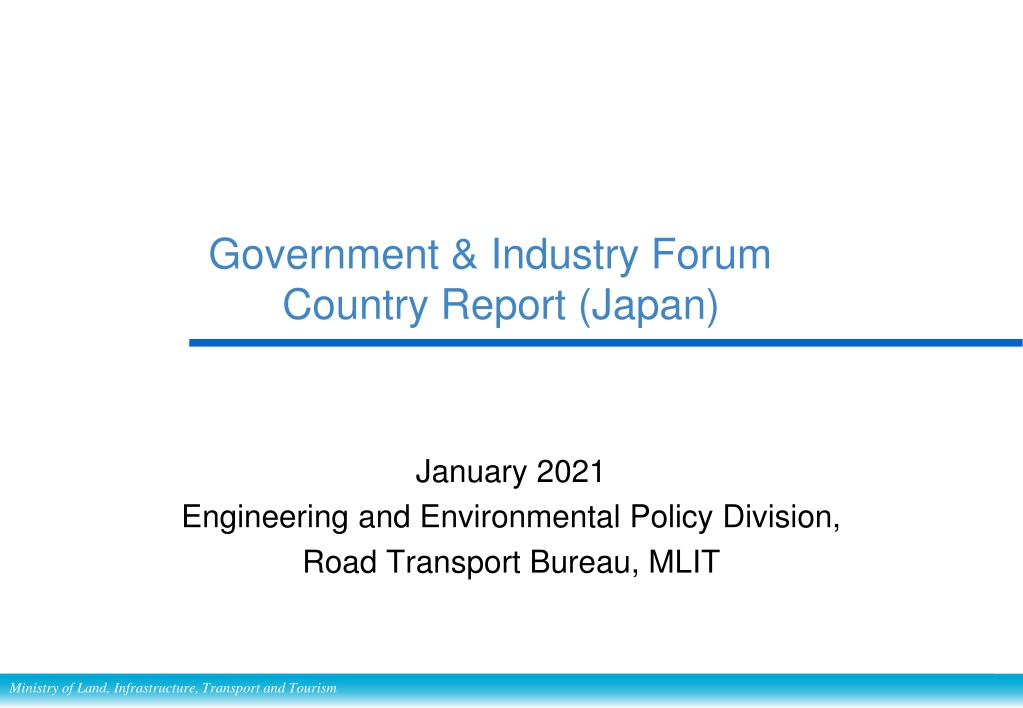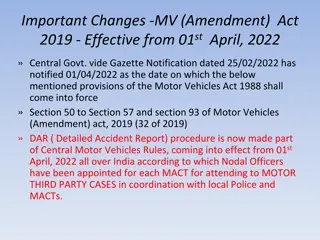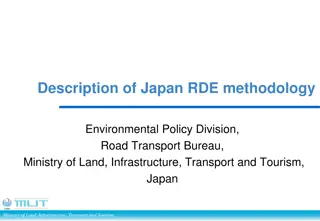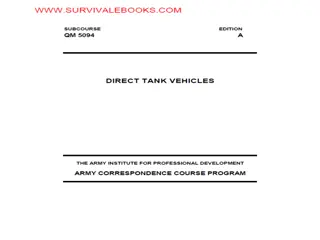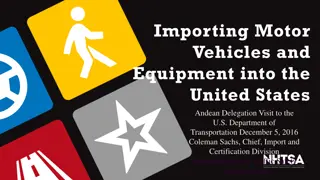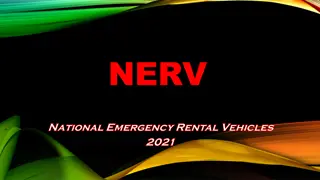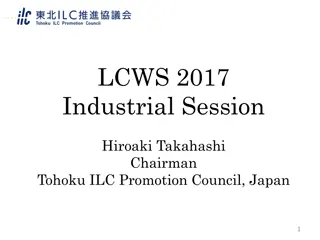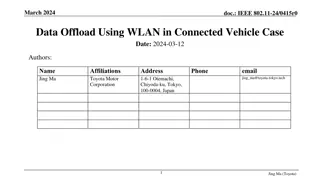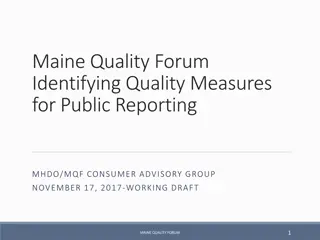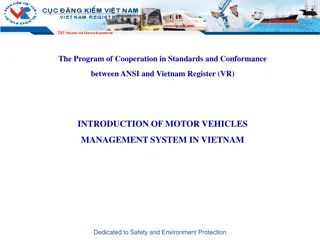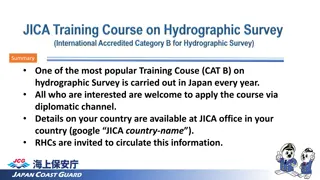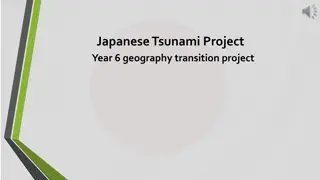Government & Industry Forum Country Report: Japan Safety and Environmental Measures for Motor Vehicles
This report from the Government & Industry Forum in Japan highlights safety and environmental measures for motor vehicles. It covers topics such as traffic accidents, government targets, vehicle safety promotion, automated driving, emission control, and international harmonization of regulations. The report emphasizes the need for collaboration between the government and industry to enhance vehicle safety and reduce accidents, with a focus on implementing advanced safety technologies in vehicles.
Download Presentation

Please find below an Image/Link to download the presentation.
The content on the website is provided AS IS for your information and personal use only. It may not be sold, licensed, or shared on other websites without obtaining consent from the author. Download presentation by click this link. If you encounter any issues during the download, it is possible that the publisher has removed the file from their server.
E N D
Presentation Transcript
Government & Industry Forum Country Report (Japan) January 2021 Engineering and Environmental Policy Division, Road Transport Bureau, MLIT Ministry of Land, Infrastructure, Transport and Tourism
Contents 1. Safety Measures for Motor Vehicles (1) Overview of traffic accidents and government targets (2) Promotion of vehicle safety measures (3) Promotion of automated driving (4) Vehicle inspection and maintenance (5) Proper maintenance and management of motor vehicles 2. Environmental Measures for Motor Vehicles (1) Government policy and status of carbon dioxide emissions (2) Development and promotion of environmentally friendly vehicles (3) Promotion of emission control measures 3. International Harmonization of Vehicle Safety and Environmental Regulations 1
1. Safety Measures for Motor Vehicles 2 Ministry of Land, Infrastructure, Transport and Tourism
1. (1) Overview of traffic accidents and government targets No. of accidents (In ten thousands) No. of injuries (In ten thousand people) The 7thTraffic Safety Master Plan The 8thTraffic Safety Master Plan The 9thTraffic Safety Master Plan The 10thTraffic Safety Master Plan No. of deaths (People) 2019 No. of deaths: 3,215 2019 No. of injuries: 461,775 10thPlan target Target year: 2020 No. of deaths: 2,500 or less No. of injuries: 500,000 or less 2019 Target reduction of deaths (within 30 days) through vehicle safety measures No. of accidents: 381,237 Reduce the no. of deaths by 2,000 by 2010 (compared to 1999) Reduce the no. of deaths by 1,000 by 2020 (compared to 2010) 1999 2000 2001 2002 2003 2004 2005 2006 2007 2008 2009 2010 2011 2012 2013 2014 2015 2016 2017 2018 2019 2020 2021 No. of accidents (In 10,000) No. of deaths (People) No. of injuries (In 10,000 people) 3 Source: Road Transport Bureau, MLIT, based on data from the National Police Agency (NPA)
1. (2) Promotion of vehicle safety measures - Considering the increase in the number of fatal accidents involving elderly drivers, it is imperative for the government and industry to work together on developing and implementing measures to prevent traffic accidents involving those people. 1. Concept of safety driving support cars The term refers to passenger cars and other vehicles equipped with advanced safety technologies such as Advanced Emergency Braking Systems (AEBS) and Pedal Misapplication Prevention Device (PMPD). To increase the installation rate of AEBS in new passenger cars to 90% or more by 2020 Wide <Target> Lane Keeping Assistant System (LKAS) Basic Basic + PMPD AEBS AEBS Advanced lighting PMPD 2. Promotion of the spread and awareness of safety driving support cars - The government and industry are working together to promote the spread and awareness of safety support cars (or suppocars as they are nicknamed). 2011 2012 2013 2014 2015 2016 2017 2018 2019 - Requested automakers to expand the range of new models equipped with advanced safety technologies and to develop retrofit safe driving support devices. From November 2021 onward, AEBS will be made mandatory in phases for all newly registered passenger cars. 4
1. (3) Promotion of automated driving In response to the discussion at WP.29, the Road Transport Vehicle Act was amended as necessary in the Diet in May 2019. Automated driving of private vehicles on expressways Enacted in May 2019 Enforced in April 2020 Amendment to the Road Transport Vehicle Act - Automated driving systems (ADS) added to the systems subject to the Safety Regulation on Road Transport Vehicles. The basic principle in the development of the Safety Regulation is that the details of technical requirements should be consistent with those of relevant international regulations newly established. The Safety Regulation must be revised without delay as international regulations are revised. - The Operational Design Domains (ODD) of automated driving systems must be as determined by the MLIT. Safety is ensured by limiting the ODD of automated driving systems, such as speed, route, and weather conditions. The appropriateness of ODD set by automakers, etc. and the compliance with the Safety Regulation by ADS will be checked. 5
1. (4) Vehicle inspection and maintenance - From October 1, 2021, results of diagnosis by onboard diagnostic devices (OBD) are added to the items to be checked on periodic inspections of motor vehicles so that they will be inspected every year with a scan tool connected. Vehicles concerned: - Standard vehicles, compact vehicles, and mini-sized motor vehicles *Excluding trailing vehicles and motorcycles. Inspection method: - Vehicles will be inspected by connecting the connector of a scan tool to the OBD and reading out the results of diagnosis. *Can be substituted by visual inspection of relevant trouble codes displayed, etc. Location of the OBD port (in the cabin) Example of display OBD port Major devices to be diagnosed onboard: - Engine/motor - Braking system - Anti-lock braking systems - AEBS, automatically commanded steering systems, and automatic navigation systems (limited to those that must be alerted when not in compliance with the Safety Regulation on Road Transport Vehicles) Communications Connection OBD port - Mandatory around the driver's seat - Connector shape, etc. is standardized by ISO/SAE Scan tool Read out the DTCs recorded in ECU Maintenance method: - To be maintained in accordance with the maintenance manual provided by the automaker, etc. Note that certification may be required when performing specific types of maintenance. 6
1. (5) Proper maintenance and management of motor vehicles Vehicle Inspection and Maintenance Promotion Campaign - To raise users awareness of the necessity of proper inspection and maintenance, the MLIT, the Council for Promotion of Motor Vehicle Inspection and Maintenance, which consists of 31 automobile-related organizations, and the Liaison Committee for Prevention of Accidents Involving Wheels Falling Off of Heavy Vehicles, which consists of 15 automobile-related organizations, have taken the lead in implementing a Vehicle Inspection and Maintenance Promotion Campaign. In addition to a nationwide campaign period (September), a regional campaign periods (July in Kitami and Asahikawa areas, August in Okinawa, and October in other areas) have been set to focus on raising users awareness of the necessity and importance of inspections and maintenance, as well as how to properly conduct inspections and maintenance on heavy-duty vehicles. - Specific Measures Raising awareness of the necessity and importance of inspection and maintenance - Raise awareness of the necessity and importance of inspection and maintenance, focusing on women and age groups teens to 30s. * Widely publicize through posters, flyers, SNS, etc. * Hold events featuring local characteristics * Provide practical training on inspection and maintenance skills as well as free inspections. Raise awareness of proper inspection and maintenance methods for heavy-duty vehicles - To prevent accidents such as wheel falling off of heavy-duty vehicles and vehicle fire accidents on buses, inspections are conducted on the condition of wheels, fuel system, and other critical points. - Raise awareness of inspections and maintenance with flyers and other materials destined to heavy-duty vehicles and transport operators. Publicity and education tailored to local conditions, etc. - In cooperation with regional transport bureaus, their branch offices, and related local organizations, implement measures to resolve issues related to inspection and maintenance in local areas. 7
2. Environmental Measures for Motor Vehicles 8 Ministry of Land, Infrastructure, Transport and Tourism
2. (1) Government policy and status of carbon dioxide emissions Prime Minister Suga's policy speech at the Diet (October 26, 2020) I hereby declare that Japan aims to reduce its overall greenhouse gas emissions to zero by 2050, that is, to achieve a carbon-neutral, decarbonized society by 2050. - Of Japan's carbon dioxide emissions (in 2018), 18.5% came from the transportation sector. - Of the emissions from the transportation sector, motor vehicles emit 86.2% (15.9% of Japan's total). Carbon dioxide emissions from the transportation sector (after allocation) Carbon dioxide emissions in Japan by sector Transport (Motor vehicles, ships, etc.) 210 million tons (18.5%) - Motor vehicles as a whole account for 86.2% of the transport sector (15.9% of Japan's total). Motor vehicles (passenger transport) account for 49.6% of the transport sector (9.2% of the Japanese total) Motor vehicles (freight transport) account for 36.6% of the transport sector (6.8% of the total for Japan) Others 168 million tons (14.8%) Private - passenger cars 96.97 million tons 46.1% Breakdown - Total CO2emissions 1,138 million tons (2018) Private freight vehicles 34.43 million tons 16.4% Business and others 196 million tons (17.2%) Buses 4.1 million tons 1.9% Taxis 2.48 million tons 1.2% Motorcycles 0.79 million tons 0.4% Coastal shipping 10.32 million tons 4.9% Aviation 10.53 million tons 5.0% Railroad 8.24 million tons 3.9% Industry 398 million tons (35.0%) Commercial freight vehicles 42.55 million tons 20.2% Household 166 million tons (14.6%) 9 Source: The GHG Emissions Data of Japan (1990-2018), (Revised values) (2020)
2. (2) Development and promotion of environmentally friendly vehicles - 2020 targets for passenger car fuel efficiency, set in March 2013 in accordance with the Act Concerning the Rational Use of Energy (Energy Conservation Act), have already been achieved by many automakers. - Accordingly, a joint fuel efficiency committee of the MLIT and the METI (chaired by Professor Masahiro Shioji, Kyoto University)* began studying the passenger car fuel efficiency standard for the next phase in March 2018, and finalized a new fuel efficiency standard in June 2019. -In March 2020, national laws and regulations were revised for new fuel efficiency standards to be applied to vehicles sold from 2030 onward. * Motor Vehicle Fuel Efficiency Standards Subcommittee under the Council for Transport Policy and Motor Vehicle Assessment Standards Working Group under the General Energy Research Council Fuel efficiency standards - Next phase fuel efficiency standards: Average 25.4 km/L * 32.4% improvement in fuel efficiency compared to 2016 -Target year: 2030 km/l 35 - Scope: Gasoline vehicles Diesel vehicles LPG vehicles Pure electric vehicles(PEVs), Off-vehicle charging hybrid electric vehicles (OVC-HEVs) *Underlined are the types of vehicles newly subject to the regulation. 29.2 30 28.4 27.3 Fuel efficiency value 26.1 24.6 25 23.0 21.1 19.1 20 (km/L) 16.8 14.4 15 11.7 9.5 10 5 0 400 600 800 1000 1200 1400 1600 Vehicle weight (kg) 1800 2000 2200 2400 2600 2800 3000 - Handling of electric vehicles: For the assessment of electric vehicles and plug-in hybrid vehicles, the well-to-wheel concept will be introduced, taking into account CO2 emissions during power generation and the loss in plant-to- vehicle power transmission and recharging. 10
2. (3) Promotion of emission control measures To enhance emission control for motorcycles, relevant public notices, etc. have been revised and applied from December 2020 to new models and from November 2022 to continuing production models (excluding certain models). Item 2016 control (3rdphase) 2020 control (4thphase) (Reference) EURO5 Applied starting: Oct 2016 Dec 2020 Jan 2020 1,2 3 Class 1 2 3 Class 1 2 3 Class <130 km/h 130 km/h CO 1.14 1.14 1.14 CO CO 1.00 1.00 Emission control value (g/km) THC THC 0.100 0.10 THC 0.30 0.20 0.17 NMHC NMHC 0.068 0.068 NOx 0.07 0.07 0.09 NOx NOx 0.06 0.06 PM PM PM 0.0045 (DI only) 0.0045 (DI only) CO: 3.0% HC: 1000 ppm (Light motorcycles*1and motorcycles*2) 1600 ppm (Mopeds type I*3and mopeds type II*4) *1Motorcycles over 125 to 250 cc *2 Motorcycles over 250 cc *3 Mopeds up to 50 cc *4 Mopeds over 50 to 125 cc CO: 0.5% CO: 0.5% or manufacturer's declared value HC: None HC: 1000 ppm (Light motorcycles and motorcycles) 1600 ppm (Mopeds type I and mopeds type II) Idling Evaporation 2 g/Test 1.5 g/Test 1.5 g/Test Endurance Endurance distance: 6k/8k/24k (km) Endurance distance: 20k/35k (km) Endurance distance: 20k/35k (km) OBD II J-OBD OBD II Detecting malfunctions and deterioration of the emission reduction system OBD Circuit diagnosis (disconnection, etc.), fuel system diagnosis Detect malfunctions and deterioration of the emission reduction system 11 * Red: Where tightened
3. International Harmonization of Vehicle Safety and Environmental Regulations 12 Ministry of Land, Infrastructure, Transport and Tourism
3. International Harmonization of Vehicle Safety and Environmental Regulations - Through activities at WP.29, develop and establish vehicle safety and environmental international regulations. - Promote the utilization of the international whole vehicle type approval (IWVTA) system. Spread and promote safer and more environment-friendly vehicles, thereby reducing traffic accidents, improving air quality, and helping build up a safer and more environment-friendly international community. Participation in WP.29 and its affiliated international conferences is 70 meetings and 177 experts It was held 5 international conferences 5 international conferences by experts from related countries and international organizations (FY2019 results) 70 meetings and 177 experts dispatched (FY2019 results) System for the Development of International Regulations for AD Technology and Items to Be Discussed World Forum for Harmonization of Vehicle Regulations (WP.29) *Major member countries include Japan, US, EU, and China. International regulations so far established: Level 2: - Automatic parking (remote controlled parking) - Hands-on automatic steering (Lane keeping/Lane change) Remote controlled parking General Safety (GRSG) Passive Safety (GRSP) Noise & Tyres (GRBP) Pollution & Energy (GRPE) Automated Vehicle (GRVA) Lighting & Light Signaling (GRE) *BMW website Advanced emergenc y braking Validation of Automated Driving Functional Require- ments *Nissan website Cyber- security EDR/DSSAD * Lane change Lane keeping *Honda website Discussion bodies related to AD technology Japan s post Give a turn signal Check safety around the vehicle Lane change complete Automatic steering Working Party on Automated/Autonomous and Connected Vehicles (GRVA) Vice-chair *LEXUS website *LEXUS website Task force on Advanced emergency braking Co-chair with the EC Level 3: - Low-speed automated driving (ALKS) - Driver monitoring Co-chair with the Netherlands and Canada Task force on validation methods for AD Co-chair with the UK and the US Task force on cybersecurity Co-chair with the Netherlands and the US Task force on EDR/DSSAD 13 Task force on functional requirements Technical secretary *LEXUS website *Hino website *Operated as a joint discussion body between GRSG on EDR and GRVA on DSS
